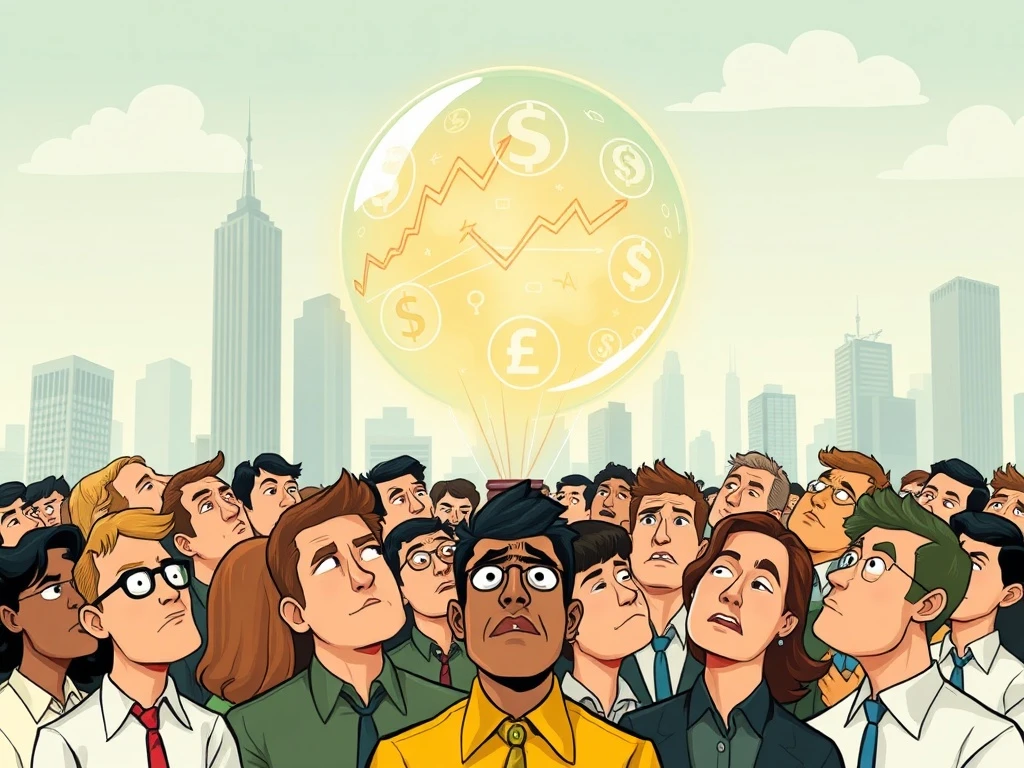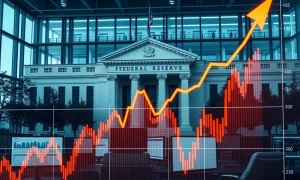Many investors feel a strong pull when stock prices reach unprecedented highs. This common sensation, often described as FOMO, or the fear of missing out, frequently accompanies periods of rapid market growth. Such sentiments, including envy and greed, can significantly influence investor behavior. Understanding these dynamics is crucial for navigating financial markets effectively. Indeed, these powerful emotions often contribute to the formation of market bubbles.
Record stock prices can certainly ignite a sense of urgency. People observe others seemingly profiting effortlessly. Consequently, they fear being left behind. This collective sentiment can create a powerful feedback loop. Prices climb higher, drawing in more participants. However, this surge is not always sustainable. It often signals an overheating market. Therefore, recognizing the signs of potential market bubbles becomes essential for any investor.
Understanding Market Bubbles: What Are They?
A market bubble occurs when asset prices rise rapidly. These prices become disconnected from their intrinsic value. Speculative trading primarily drives this detachment. Furthermore, irrational exuberance often replaces fundamental analysis. The bubble then expands, attracting more investors. They buy assets based on the expectation of further price increases. They do not consider underlying value.
Typically, a market bubble follows a predictable lifecycle:
- Displacement: A new paradigm or innovation emerges. This could be a technological breakthrough or a change in financial policy.
- Boom: Prices rise steadily at first. Then, they accelerate rapidly. Investors gain confidence.
- Euphoria: Speculation dominates the market. Prices surge vertically. New investors enter, driven by FOMO and greed. They ignore traditional valuation metrics.
- Crisis/Bust: The bubble bursts. Prices collapse quickly. Panic selling ensues. Investors lose significant wealth.
Understanding these stages helps identify a developing bubble. Moreover, it prepares investors for the eventual downturn. History offers many examples of such phenomena. These historical instances provide valuable lessons.
The Psychology of Market Bubbles: FOMO, Greed, and Envy
Human psychology plays a pivotal role in forming market bubbles. Emotions like FOMO, greed, and envy drive collective behavior. These feelings can override rational decision-making. Investors often succumb to herd mentality. They follow the crowd, even against their better judgment.
Firstly, **FOMO (Fear Of Missing Out)** compels individuals to invest. They see others making quick gains. They do not want to be left out. This fear creates urgency. Consequently, people rush into investments without proper research. They prioritize participation over prudence. Furthermore, social media and instant news amplify FOMO. Everyone discusses the soaring assets. This creates immense pressure to join.
Secondly, **greed** becomes a dominant force. As prices rise, investors expect even greater returns. They take on more risk. They might use leverage or invest heavily in single assets. This pursuit of maximum profit blinds them to potential dangers. They ignore warning signs. Instead, they focus solely on potential upside. This excessive optimism fuels further price increases.
Thirdly, **envy** emerges. Investors observe peers or even strangers accumulating wealth. This creates a desire to replicate those successes. They might feel inadequate if they are not participating. This feeling can lead to impulsive decisions. They chase performance rather than value. Therefore, understanding these emotional biases is critical. It helps investors make more rational choices.
Historical Market Bubbles: Lessons from the Past
History provides clear illustrations of market bubbles. These past events offer valuable insights. They demonstrate the consistent patterns of speculative excess and subsequent collapse. Learning from them can help current investors.
The Tulip Mania (1637)
The Dutch Tulip Mania is often cited as the first recorded economic bubble. Tulip bulbs became incredibly valuable in the Netherlands. Prices soared to astronomical levels. Some rare bulbs traded for more than houses. People mortgaged their homes to buy tulips. They expected prices to rise indefinitely. However, the bubble burst suddenly. Prices plummeted. Many investors faced financial ruin. This event highlights the dangers of speculation divorced from intrinsic value.
The Dot-Com Bubble (Late 1990s)
The late 1990s saw a massive surge in technology stocks. Companies with little revenue or profit achieved massive valuations. Investors poured money into internet-related businesses. They believed the internet would revolutionize everything. Traditional valuation metrics were largely ignored. Companies like Pets.com and Webvan gained huge market caps. However, the bubble began to deflate in early 2000. Many dot-com companies went bankrupt. Major indices like the NASDAQ lost significant value. This era demonstrated the risk of investing based purely on hype.
The U.S. Housing Bubble (Mid-2000s)
The mid-2000s witnessed a significant housing bubble in the United States. Mortgage lending standards loosened considerably. Home prices surged nationwide. Many people bought homes they could not afford. They often used adjustable-rate mortgages. Speculators also bought properties, expecting quick profits. This led to widespread overvaluation. The bubble burst in 2007-2008. This triggered the global financial crisis. Millions lost their homes. Financial institutions faced collapse. This bubble underscored the systemic risks of excessive leverage and lax regulation.
These historical examples show common themes. Speculative behavior, excessive optimism, and detachment from fundamentals are recurring elements. Recognizing these patterns helps investors navigate current market conditions.
Identifying Signs of a Potential Market Bubble
Identifying a potential market bubble requires careful observation. Investors must look beyond headlines and hype. Several key indicators often signal an overheated market. Prudent investors pay close attention to these signs. They help in making informed decisions.
Here are common indicators:
- Rapid Price Appreciation: Asset prices increase at an unsustainable rate. They often detach from historical norms. This rapid ascent often occurs without a corresponding increase in earnings or fundamentals.
- Widespread Speculation: Many new, inexperienced investors enter the market. They often buy assets purely on the expectation of rising prices. They ignore traditional valuation methods.
- Detachment from Fundamentals: Company valuations become excessive. Price-to-earnings (P/E) ratios soar. Price-to-sales ratios also reach unprecedented levels. These metrics suggest overvaluation compared to underlying business performance.
- Easy Credit and Leverage: Lenders offer easy credit. This allows more people to invest. High levels of leverage amplify both gains and losses. This increases systemic risk.
- “New Paradigm” Narratives: Proponents argue that “this time is different.” They claim traditional rules no longer apply. They suggest a new era of perpetual growth. This narrative often accompanies bubbles.
- Public Enthusiasm and Media Hype: Investment topics dominate public discourse. Everyone, including taxi drivers and barbers, discusses hot stocks. Media coverage becomes overwhelmingly positive. It often highlights only success stories.
Observing these signs does not guarantee a bubble will burst immediately. However, they indicate increased risk. Investors should proceed with caution.
Navigating Market Bubbles: Strategies for Prudent Investors
Navigating periods of potential market bubbles demands discipline. Investors must resist emotional impulses. Instead, they should focus on long-term financial goals. Adopting sound strategies helps protect capital. It also positions investors for future opportunities. Here are some key approaches:
- Maintain Diversification: Do not put all your eggs in one basket. Diversify across different asset classes. Include stocks, bonds, real estate, and commodities. Diversify within stock portfolios too. Spread investments across various industries and geographies. This strategy reduces risk. If one sector crashes, others might remain stable.
- Focus on Fundamentals: Invest in companies with strong balance sheets. Look for consistent earnings growth. Prioritize businesses with competitive advantages. Do not chase speculative assets. Valuation matters. A company’s true value comes from its earnings and assets.
- Practice Risk Management: Define your risk tolerance. Do not over-leverage. Avoid taking on excessive debt for investments. Set stop-loss orders if appropriate. Regularly review your portfolio. Adjust it to match your risk profile.
- Adopt a Long-Term Perspective: Short-term market fluctuations are common. Market bubbles can inflate and burst quickly. However, a long-term view helps weather volatility. Focus on compounding returns over years, not months. Patient investors often achieve greater success.
- Maintain Cash Reserves: Keep some cash available. This provides liquidity during downturns. It allows you to buy assets at lower prices. When a bubble bursts, opportunities emerge. Cash enables you to seize them.
- Rebalance Your Portfolio: Regularly rebalance your portfolio. If one asset class grows disproportionately, trim it. Reallocate funds to underperforming areas. This ensures your portfolio remains aligned with your target asset allocation. It also forces you to sell high and buy low.
These strategies empower investors. They help mitigate risks associated with market bubbles. They also promote sustainable growth.
Beyond the Hype: Avoiding Common Pitfalls in Market Bubbles
Avoiding the common pitfalls associated with market bubbles is crucial. Emotional investing often leads to poor outcomes. Staying rational during periods of euphoria can be challenging. However, it is essential for protecting your wealth. Here are key pitfalls to avoid:
- Emotional Investing: Do not let FOMO, greed, or envy dictate your decisions. Develop a clear investment plan. Stick to it regardless of market sentiment. Emotions can cloud judgment. They lead to impulsive actions.
- Herd Mentality: Resist the urge to follow the crowd. Just because everyone else is buying a particular asset does not make it a sound investment. Independent research is vital. Challenge popular narratives.
- Ignoring Valuation: Never ignore fundamental valuation metrics. A high price-to-earnings ratio might indicate overvaluation. Understand what you are buying. Ensure the price reflects a reasonable expectation of future earnings.
- Excessive Leverage: Borrowing heavily to invest amplifies both gains and losses. While it can accelerate profits in a rising market, it can lead to devastating losses during a downturn. Avoid taking on too much debt.
- Speculating on “Hot Tips”: Be wary of unsolicited investment advice. “Hot tips” often come from unreliable sources. They are rarely based on sound analysis. Conduct your own due diligence.
- Believing “This Time Is Different”: History often repeats itself. Market bubbles follow similar patterns. Do not fall for the narrative that current conditions defy historical precedents. Fundamental economic principles generally remain constant.
By consciously avoiding these traps, investors can navigate volatile markets more safely. They can protect their capital from the inevitable burst of a bubble.
The Current Landscape: Record Stock Prices and Market Bubbles
Today’s financial landscape features record stock prices. This naturally raises questions about potential market bubbles. Many indices have reached all-time highs. Investor sentiment appears robust. However, this period also shows some characteristics of past bubbles. Therefore, investors must remain vigilant.
Current record prices are driven by several factors. Strong corporate earnings play a role. Technological advancements also contribute. Furthermore, low interest rates have made stocks more attractive. However, some valuations appear stretched. Certain sectors exhibit rapid, speculative growth. This growth sometimes outpaces underlying business performance. For instance, some technology or growth stocks show very high price-to-earnings ratios. This suggests high future growth expectations. Yet, these expectations may not materialize.
The prevalence of retail investors is also notable. Many new participants have entered the market. They often use accessible trading platforms. This increased participation can fuel rapid price movements. Social media further amplifies trends. It creates a sense of collective excitement. This environment can foster emotional decision-making. Investors might overlook risks. They focus instead on short-term gains. This behavior resembles patterns seen in historical bubbles.
No one can predict when or if a bubble will burst. However, recognizing the signs is paramount. Investors should evaluate their portfolios. They should ensure their investments align with their risk tolerance. Maintaining a balanced perspective is crucial. It helps avoid succumbing to widespread euphoria or panic. Staying informed about market fundamentals is also essential. This allows for more rational investment choices in a dynamic environment.
Conclusion
The allure of record stock prices is undeniable. It often triggers feelings of FOMO, envy, and greed among investors. These powerful emotions are not unique. They have historically contributed to the formation of market bubbles. Understanding the psychology behind these phenomena is therefore vital. Investors must recognize the stages of a bubble. They should also identify its tell-tale signs. These include rapid price appreciation and widespread speculation. Learning from past bubbles, such as the Tulip Mania or the Dot-Com era, provides invaluable lessons. These historical events underscore the dangers of detached valuations.
Navigating a market potentially inflated by speculative fervor requires discipline. Prudent investors maintain diversified portfolios. They focus on fundamental value. They also manage risk effectively. Avoiding common pitfalls like emotional investing and herd mentality is crucial. While current record stock prices reflect various factors, vigilance remains paramount. By adopting a rational, long-term approach, investors can protect their wealth. They can also position themselves for sustainable financial growth, regardless of market sentiment.
Remember, financial markets are cyclical. Bubbles inflate and eventually deflate. Informed decision-making, rather than emotional reaction, serves as the best defense. Stay grounded in sound investment principles. This approach helps ensure long-term success.
Frequently Asked Questions (FAQs)
What exactly is a market bubble?
A market bubble occurs when an asset’s price significantly exceeds its intrinsic value. This overvaluation is driven by speculative buying rather than fundamental analysis. Investors purchase the asset expecting its price to rise indefinitely, creating an unsustainable surge. Eventually, the bubble bursts, leading to a rapid price collapse.
How do FOMO, greed, and envy contribute to market bubbles?
These emotions fuel irrational exuberance. FOMO (Fear Of Missing Out) compels people to invest to avoid being left behind. Greed drives investors to seek maximum profits, often taking excessive risks. Envy arises from observing others’ success, leading to impulsive investments. Collectively, these emotions override rational judgment, accelerating price increases and expanding the bubble.
What are common signs that a market bubble might be forming?
Key signs include rapid, unsustainable price increases, widespread public enthusiasm for specific assets, a detachment of asset prices from their underlying fundamentals, easy access to credit for speculative investments, and a prevalent narrative that “this time is different.” New, inexperienced investors often enter the market during this phase.
Can I profit from a market bubble, and what are the risks?
Some investors may profit by accurately timing the bubble’s inflation and selling before it bursts. However, this is extremely difficult and highly risky. The primary risk is holding assets when the bubble bursts, leading to significant and rapid losses. Most experts advise against trying to “time the market” during a bubble.
How can investors protect themselves from the risks of market bubbles?
Investors can protect themselves by diversifying their portfolios across various asset classes, focusing on fundamental analysis rather than speculative trends, maintaining a long-term investment perspective, managing risk through appropriate asset allocation, and keeping some cash reserves. Avoiding emotional decision-making and herd mentality is also crucial.
Are current record stock prices a definite sign of a market bubble?
Record stock prices alone do not definitively confirm a market bubble. They can reflect strong corporate earnings, economic growth, and low interest rates. However, when combined with signs like extreme valuations, widespread speculation, and detachment from fundamentals in certain sectors, they suggest a heightened risk. Investors should remain vigilant and apply prudent investment strategies.
























